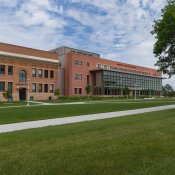
Solberg Hall is home to the construction and operations management department. This historic building is connected to the Chicoine Architecture, Mathematics and Engineering Hall.
Building Description
The main level of the building has a large mural that shows students and faculty activities since it was constructed in 1901. The department office is located on this floor, along with a computer design and modeling lab plus general classroom spaces.
The second level has construction management and operations management computer labs, offices and classrooms. Third level has electronics engineering technology and prototype labs. The lower level of the building has general classrooms and department research labs.
Solberg Hall was built in 1901 for $65,000 and named in honor of Halvor Christian Solberg, the man who introduced mechanical engineering to SDSU. Solberg drove the first car in Brookings in 1904 and started an automobile engineering course before anyone recognized that the automobile was here to stay. He drew up plans for Highway 14 from Winona, Minnesota to the Black Hills, as well as numerous other projects.
The Physics and Engineering Building, as it was called then, was built as a two-story structure. A third floor was added between 1910 and 1920. The one-story annex east of the original building resulted from two more additions between 1920 and 1930. In the lower level of Solberg Hall, 1907 electrical engineering graduate Stephen F. Briggs invented the single-cylinder, internal combustion gasoline engine that went on to become a household name. Briggs went on to be co-founder of the Briggs & Stratton Corporation, home to the Briggs & Stratton engine. The building was renovated in 2003.
Video Tour
Physical Address:
907 Campanile Ave.Brookings, SD 57007
Interactive Map
The interactive map allows users to plot directions between buildings and show locations of highlighted features and services across the SDSU campus. Click on the image below to direct you to the SDSU interactive map.

